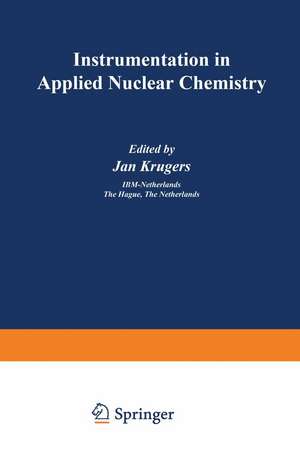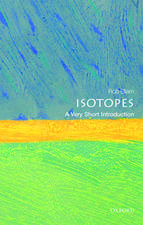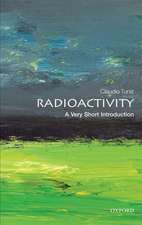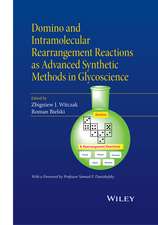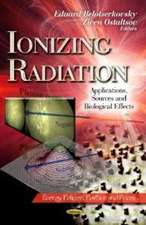Instrumentation in Applied Nuclear Chemistry
Editat de Jan Krugersen Limba Engleză Paperback – 27 dec 2012
Preț: 394.29 lei
Nou
Puncte Express: 591
Preț estimativ în valută:
75.45€ • 78.100$ • 62.58£
75.45€ • 78.100$ • 62.58£
Carte tipărită la comandă
Livrare economică 09-23 aprilie
Preluare comenzi: 021 569.72.76
Specificații
ISBN-13: 9781468419559
ISBN-10: 1468419552
Pagini: 400
Ilustrații: XIV, 383 p.
Dimensiuni: 155 x 235 x 21 mm
Greutate: 0.56 kg
Ediția:Softcover reprint of the original 1st ed. 1973
Editura: Springer Us
Colecția Springer
Locul publicării:New York, NY, United States
ISBN-10: 1468419552
Pagini: 400
Ilustrații: XIV, 383 p.
Dimensiuni: 155 x 235 x 21 mm
Greutate: 0.56 kg
Ediția:Softcover reprint of the original 1st ed. 1973
Editura: Springer Us
Colecția Springer
Locul publicării:New York, NY, United States
Public țintă
ResearchCuprins
1 Basic Theory of Nuclear Processes.- 1.1. Introduction.- 1.2. Atoms and Nuclei.- 1.3. Nuclear Models.- 1.4. Radiation.- 1.5. Nuclear Reactions and Radioactivity.- 1.6. Interaction of Radiation with Matter.- 1.7. References.- 2 Systems and Their Use.- 2.1. Introduction.- 2.2. Detectors.- 2.3. Instrumentation.- 2.4. References.- 3 Applications.- 3.1. Introduction.- 3.2. Neutron Activation Analysis.- 3.3. Fluorescence Analysis.- 3.4. Mössbauer Effect.- 3.5. Tracers and Labeling of Molecules.- 3.6. Radiodating techniques.- 3.7. Absolute Activity.- 3.8. Hot Atom Chemistry.- 3.9. Radiation Chemistry.- 3.10. Half-Life Measurement.- 3.11. References.- 4 Detectors.- 4.1. Introduction.- 4.2. Detector Physics in General.- 4.3. Gas-Filled Radiation Detectors.- 4.4. Scintillation Detectors.- 4.5. Semiconductor Detectors.- 4.6. Spectrum Interpretation.- 4.7. Background.- 4.8. References.- 5 NIM Standard.- 5.1. Introduction.- 5.2. Need for a Standard Modular System.- 5.3. History of Development.- 5.4. Advantages.- 5.5. Description.- 5.6. Power Supplies.- 5.7. Typical NIM Instruments.- 5.8. Nonnuclear NIM Instrumentation.- 5.9. CAMAC.- 5.10. Future of NIM.- 5.11. References and Notes.- 6 Preamplifiers.- 6.1. Introduction.- 6.2. Signal Sources in Nuclear Electronics.- 6.3. Basic Types of Preamplifiers.- 6.4. Coupling the Preamplifier with the Detector and Other Equipment.- 6.5. Noise.- 6.6. Considerations in Choosing a Preamplifier.- 6.7. References and Notes.- 7 Amplifiers.- 7.1. Introduction.- 7.2. Feedback Loops.- 7.3. Biased Amplifiers.- 7.4. Shaping.- 7.5. Timing.- 7.6. High Count Rates.- 7.7. Causes and Remedies of Poor Resolution.- 7.8. Specifications and Features.- 7.9. References and Notes.- 8 Single-Channel Analysers.- 8.1. Introduction.- 8.2. Components andCharacteristics.- 8.3. Single-Channel Analyzer Applications.- 8.4. Selecting a Single-Channel Analyzer for Your Application.- 8.5. Typical Applications of Single-Channel Analyzers.- 8.6. References.- 9 Multichannel Analyzers.- 9.1. Introduction.- 9.2. Applications.- 9.3. Hardware Organization.- 9.4. Characteristics.- 9.5. Conclusion and Future.- 9.6. References.- 10 Statistics.- 10.1. Need for Statistical Considerations.- 10.2. Basics.- 10.3. Variables.- 10.4. Conditions.- 10.5. Formulas for Standard Deviation, Detection limit, and Figure of Merit.- 10.6. Use of Formulas.- 10.7. References and Notes.- 11 Timing Circuits.- 11.1. Introduction.- 11.2. Timing Circuits.- 11.3. Applications of Timing Circuits.- 11.4. References and Notes.- 12 Use of Computers.- 12.1. Introduction.- 12.2. The Computer Interface.- 12.3. Equipment Calibration.- 12.4. Data Acquisition.- 12.5. Experiment Control and Monitoring.- 12.6. Computer-Based Multichannel Analyzers.- 12.7. Data Reduction.- 12.8. Data Analysis.- 12.9. References.
